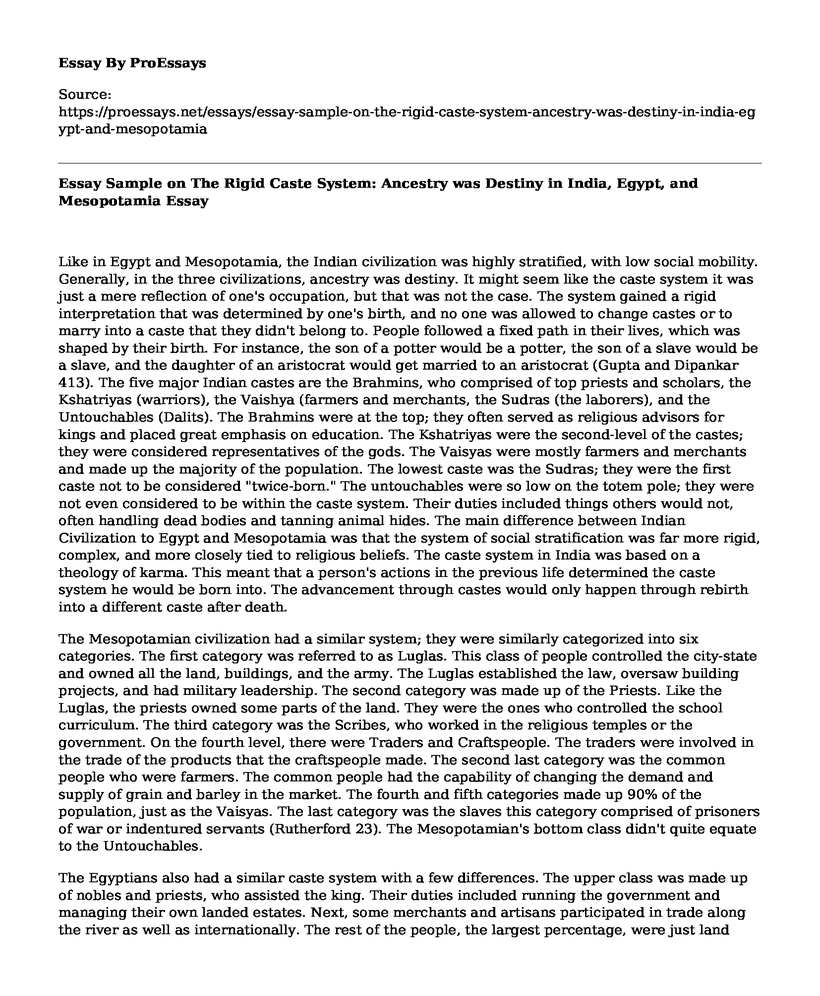Like in Egypt and Mesopotamia, the Indian civilization was highly stratified, with low social mobility. Generally, in the three civilizations, ancestry was destiny. It might seem like the caste system it was just a mere reflection of one's occupation, but that was not the case. The system gained a rigid interpretation that was determined by one's birth, and no one was allowed to change castes or to marry into a caste that they didn't belong to. People followed a fixed path in their lives, which was shaped by their birth. For instance, the son of a potter would be a potter, the son of a slave would be a slave, and the daughter of an aristocrat would get married to an aristocrat (Gupta and Dipankar 413). The five major Indian castes are the Brahmins, who comprised of top priests and scholars, the Kshatriyas (warriors), the Vaishya (farmers and merchants, the Sudras (the laborers), and the Untouchables (Dalits). The Brahmins were at the top; they often served as religious advisors for kings and placed great emphasis on education. The Kshatriyas were the second-level of the castes; they were considered representatives of the gods. The Vaisyas were mostly farmers and merchants and made up the majority of the population. The lowest caste was the Sudras; they were the first caste not to be considered "twice-born." The untouchables were so low on the totem pole; they were not even considered to be within the caste system. Their duties included things others would not, often handling dead bodies and tanning animal hides. The main difference between Indian Civilization to Egypt and Mesopotamia was that the system of social stratification was far more rigid, complex, and more closely tied to religious beliefs. The caste system in India was based on a theology of karma. This meant that a person's actions in the previous life determined the caste system he would be born into. The advancement through castes would only happen through rebirth into a different caste after death.
The Mesopotamian civilization had a similar system; they were similarly categorized into six categories. The first category was referred to as Luglas. This class of people controlled the city-state and owned all the land, buildings, and the army. The Luglas established the law, oversaw building projects, and had military leadership. The second category was made up of the Priests. Like the Luglas, the priests owned some parts of the land. They were the ones who controlled the school curriculum. The third category was the Scribes, who worked in the religious temples or the government. On the fourth level, there were Traders and Craftspeople. The traders were involved in the trade of the products that the craftspeople made. The second last category was the common people who were farmers. The common people had the capability of changing the demand and supply of grain and barley in the market. The fourth and fifth categories made up 90% of the population, just as the Vaisyas. The last category was the slaves this category comprised of prisoners of war or indentured servants (Rutherford 23). The Mesopotamian's bottom class didn't quite equate to the Untouchables.
The Egyptians also had a similar caste system with a few differences. The upper class was made up of nobles and priests, who assisted the king. Their duties included running the government and managing their own landed estates. Next, some merchants and artisans participated in trade along the river as well as internationally. The rest of the people, the largest percentage, were just land workers. They were typically bound to the land and cultivated the crops to pay taxes to the king. In Egyptian culture, women were also allowed to operate businesses, unlike the Indian culture.
Work Cited
Gupta, Dipankar. "Caste and politics: Identity over system." Annu. Rev. Anthropol. 34 (2005): 409-427. file:///C:/Users/DELL/Desktop/soft%20copy.pdf
Stiebing Jr, William H. Ancient near eastern history and culture. Routledge, 2016. https://www.worldcat.org/title/ancient-near-eastern-history-and-culture/oclc/953658925
Cite this page
Essay Sample on The Rigid Caste System: Ancestry was Destiny in India, Egypt, and Mesopotamia. (2023, May 07). Retrieved from https://proessays.net/essays/essay-sample-on-the-rigid-caste-system-ancestry-was-destiny-in-india-egypt-and-mesopotamia
If you are the original author of this essay and no longer wish to have it published on the ProEssays website, please click below to request its removal:
- Why the Provision of Both 1820 and 1850 Didn't Stop the Civil War
- The Life and Works of Chopin Essay
- Research Paper on American Liberty
- Essay Sample on Structural Realism After the Cold War
- Essay Example on Aristotle: The Greatest Thinker & His Lasting Impact
- Essay Example on Women in Colonial America: Role and Experiences
- Unlocking the Secrets of Our Neandertal Relatives: 400,000 Years of History - Essay Sample







